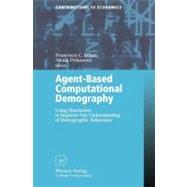
| Introduction: Agent-Based Computational Demography | 1 | (18) | |||
|
|||||
|
1 | (2) | |||
|
3 | (1) | |||
|
4 | (2) | |||
|
6 | (1) | |||
|
6 | (5) | |||
|
11 | (4) | |||
|
15 | (4) | |||
| Data, Models, Theory and Reality: The Structure of Demographic Knowledge | 19 | (22) | |||
|
|||||
|
19 | (3) | |||
|
22 | (5) | |||
|
27 | (1) | |||
|
28 | (4) | |||
|
32 | (3) | |||
|
35 | (2) | |||
|
37 | (2) | |||
|
39 | (2) | |||
| The Role of Agent-Based Modelling in Demographic Explanation | 41 | (14) | |||
|
|||||
|
41 | (1) | |||
|
42 | (4) | |||
|
46 | (1) | |||
|
47 | (1) | |||
|
48 | (3) | |||
|
51 | (1) | |||
|
52 | (1) | |||
|
53 | (2) | |||
| Diffusion Processes in Demographic Transitions: A Prospect on Using Multi Agent Simulation to Explore the Role of Cognitive Strategies and Social Interactions | 55 | (18) | |||
|
|||||
|
55 | (3) | |||
|
58 | (1) | |||
|
59 | (3) | |||
|
62 | (2) | |||
|
64 | (3) | |||
|
67 | (2) | |||
|
69 | (1) | |||
|
70 | (3) | |||
| The Collapse of the Berlin Wall: Simulating State-Level East to West German Migration Patterns | 73 | (24) | |||
|
|||||
|
73 | (1) | |||
|
74 | (1) | |||
|
75 | (1) | |||
|
76 | (1) | |||
|
77 | (5) | |||
|
82 | (10) | |||
|
92 | (1) | |||
|
93 | (4) | |||
| Agent-Based Modeling of Householders' Migration Behavior and Its Consequences | 97 | (20) | |||
|
|||||
|
97 | (1) | |||
|
98 | (4) | |||
|
102 | (1) | |||
|
103 | (9) | |||
|
112 | (1) | |||
|
112 | (1) | |||
|
113 | (4) | |||
| Population-Wide Marriage Patterns Produced by Individual Mate-Search Heuristics | 117 | (22) | |||
|
|||||
|
117 | (1) | |||
|
118 | (5) | |||
|
123 | (12) | |||
|
135 | (1) | |||
|
136 | (3) | |||
| On the Cultural Evolution of Age-at-Marriage Norms | 139 | (20) | |||
|
|||||
|
139 | (1) | |||
|
140 | (3) | |||
|
143 | (3) | |||
|
146 | (9) | |||
|
155 | (1) | |||
|
156 | (3) | |||
| Bringing Behavior Back into Micro-Simulation: Feedback Mechanisms in Demographic Models | 159 | (16) | |||
|
|||||
|
159 | (5) | |||
|
164 | (2) | |||
|
166 | (6) | |||
|
172 | (1) | |||
|
173 | (2) | |||
| Consequences of Mortality Crises in Pre-Modern European Towns: A Multiagent-Based Simulation Approach | 175 | (22) | |||
|
|||||
|
175 | (2) | |||
|
177 | (1) | |||
|
177 | (8) | |||
|
185 | (8) | |||
|
193 | (1) | |||
|
194 | (3) | |||
| Agents, Hierarchies and Sustainability | 197 | ||||
|
|||||
|
197 | (3) | |||
|
200 | (6) | |||
|
206 | (3) | |||
|
209 | (1) | |||
|
210 |
The New copy of this book will include any supplemental materials advertised. Please check the title of the book to determine if it should include any access cards, study guides, lab manuals, CDs, etc.
The Used, Rental and eBook copies of this book are not guaranteed to include any supplemental materials. Typically, only the book itself is included. This is true even if the title states it includes any access cards, study guides, lab manuals, CDs, etc.